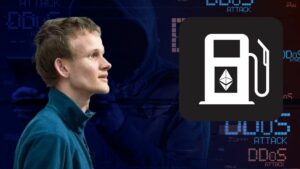Ethereum’s transition to a Proof-of-Stake (PoS) chain is getting into final phases and Vitalik Buterin has introduced yet another proposal, Proto-Danksharding (EIP-4844), to improve Ethereum 2.0’s sharding mechanism.
Ethereum co-founder Vitalik Buterin took to Twitter on Saturday, March 19, to introduce his own Ethereum Improvement Proposal-4844 (EIP-4844) that aims to bring more improvements to Ethereum 2.0 sharding mechanism. The EIP-4844 will replace the current Danksharding mechanism with Proto-Danksharding bringing a novel way to organize data logistics for Ethereum.
My own EIP-4844 (aka. proto-danksharding) technical FAQ:https://t.co/SlgNERBYVc
— vitalik.eth (@VitalikButerin) March 19, 2022
What is Proto-DankSharding (EIP-4844)?
As Crypto Economy reported, the Ethereum PoW network had been merged with its PoS public testnet Klin. On March 15, the Kiln testnet was launched and this means that Ethereum 2.0 is now available in testnet. The Kiln testnet is intended to be the final merge testnet built before the upgrade of existing public testnets.
The current Ethereum sharding is rollup-centric. In sharding, multiple interconnected blockchains work in parallel to increase transaction throughput. However, in Danksharding, instead of providing more space for transactions, the Ethereum network only checks if blobs of data are available to be downloaded from the network. “The data space in these blobs is expected to be used by layer-2 rollup protocols that support high-throughput transactions.”
![Ethereum [ETH] Vitalik Buterin talks about the progress made in Ethereum 2.0](https://crypto-economy.com/wp-content/uploads/2022/12/ethereum-2.0.jpg)
Currently, Ethereum is using Danksharding as its sharding mechanism in its Kiln testnet. The document explaining the EIP-4844 explains Danksharding as:
“The main innovation introduced by Danksharding is the merged fee market: instead of there being a fixed number of shards that each have distinct blocks and distinct block proposers, in Danksharding there is only one proposer that chooses all transactions and all data that go into that slot.”
Danksharding uses a proposer/builder separation (PBS) technique where a “specialized class of actors called block builders bid on the right to choose the contents of the slot.” The block producer with the highest bid gets selected and processes the entire block. All other validators simply verify the block through data availability sampling.
At @EthereumDenver we hacked together a full data-blob-transaction prototype! (a.k.a. mini-danksharding)
Data blobs are the first milestone towards full ethereum sharding, enabling rollups like @optimismPBC to grow 100x in capacity.
Here's a tweet thread about the prototype 🧵
— proto.eth (@protolambda) February 20, 2022
The proposed Proto-Danksharding will be an interim variant of the Danksharding mechanism as it includes the implementation of some Danksharding elements. The document reads:
“The main feature introduced by Proto-Danksharding is a new transaction type, which we call a blob-carrying transaction. A blob-carrying transaction is like a regular transaction, except it also carries an extra piece of data called a blob. Blobs are extremely large (~125 kB) and can be much cheaper than similar amounts of call data. However, blob data is not accessible to EVM execution; the EVM can only view a commitment to the blob.”
According to the original draft of the EIP-4844, until Ethereum 2.0 is fully ready to do all the work, Proto-Danksharding will provide a stop-gap solution by implementing the transaction format that would be used in sharding, but not actually sharding those transactions. EIP-4844 also proposes to auto-delete blob data every 30 days to prevent the network from the too-large requirement for data and memory storage.



![What is Ethereum [ETH]?](https://crypto-economy.com//wp-content/uploads/2022/03/ethereum-1-1024x576.jpg)








